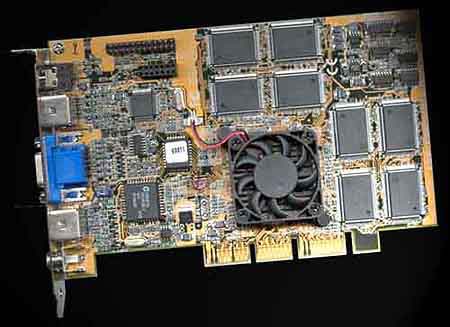Hardware
Audio
Controllers
General
Mainboards
Memory
Modems
Monitors
Portables
Printers
Processors
Scanners
Storage
Video
Games
Reviews
Previews
Cheats
& Hints
News
General Info
|
ASUS AGP-V3800 Ultra Deluxe Last
year, ASUS made one of the best graphics cards based on the Riva TNT chipset;
the AGP V3400, a full-featured card with solid driver support and also
very overclockable into the bargain. Now they have built a brand-new series
of graphics cards based on nVidiaís TNT2 chipset, the AGP-V3800 series.
This lineup consists of three cards based on the TNT2 chipset and one high-end
part based on the Ultra TNT2 chipset, which last is the model that we tested
for this review, the AGP V3800 Ultra Deluxe.
But there is also a big difference- this is one of very few cards that feature SGRAM instead of SDRAM. Naturally, one of the first questions that spring to mind on hearing that is whether the price of this unit slightly higher than the average Ultra TNT2 card. Well, yes, it is... but the high price of the card is not affected by the type of the video memory alone, because the card has video-in, TV-out, VR 3D Glasses, and a LCD out. As you can see, this is no ordinary card and the retail price tag of $260+ is fully justified by the stellar list of features. With
the ASUS V3400, TNT users were treated to an incredibly well performing
card with plenty of overclockability and some nifty video capture abilities.
Following up, the V3800 line of cards takes this to the next level with
TNT2 performance, higher video capture sizes and a list of upgrade options
that could take up a shelf at your local electronics store. The V3800TVR
Deluxe kit that Iím reviewing is a TNT2 based card with 32MB of RAM, TV-in
and TV-out and a nifty set of 3D LCD glasses as well.
The
package includes an easy installation utility and some video capturing
software. However I did have some problems with the drivers and getting the Dual-View
option to work. So the installation process wasn't hassle-free. For beginners
I recomend going through all documentation before installing the card, though of course if youíre
ASUS
provides their standard VR Glasses with this kit; the glasses look a bit
bulky and arenít as nice looking as the Elsa
Revelator glasses, which had a more streamlined, modern look to it.
But hey, other than the appearance, the glasses work great on Direct 3D
games. The video input on the unit allows the user to plug in a VCR and
capture video at window sizes up to 352 x 240 NTSC and 352 x 288 PAL. Since
the unit supports NTSC and PAL color schemes, many users worldwide will
be able to enjoy the video capturing features. But keep in mind that the
card has no onboard tuner, so you cannot plug in your antenna or cable
TV jack for direct TV on PC. Thatís what the $90 TV box is for. Apart
from that, the TV features work very well, the picture quality is quite
good and anyone with a Pentium II 450 or an o/c Celeron will be able to
capture vide at 30 fps without having to drop any frames at the highest
window size. Even the TV-out on this card looks nice at 800x600, not to
mention the fact that it also supports the TV-out and the monitor simultaneously
at boot up.
Now
we come to a more important point; performance. First, this card isnít
the fastest Ultra TNT2 card and itís not meant to be because the core and
the memory clocks are set to 150MHz and 183MHz respectively. However, the
V3800 Ultra Deluxe cards can be overclocked to 175/200. At this setting,
|
|
|
|
|

